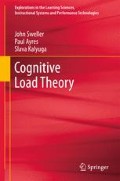Abstract
The redundancy effect may appear on the surface to be related to the split-attention effect but in fact is quite unrelated. There are similarities because both effects deal with multiple sources of information such as visuals and text. As is the case for the split-attention effect, any combination of diagrams, pictures, animations and spoken or written verbal information can lead to the generation of extraneous cognitive load. Nevertheless, despite their surface similarities, the redundancy effect has very different characteristics to the split-attention effect. The two effects differ because the logical relations between the multiple sources of information required as essential pre-requisites to produce each effect differ; that difference is critical and should never be ignored.
Access this chapter
Tax calculation will be finalised at checkout
Purchases are for personal use only
References
Bobis, J., Sweller, J., & Cooper, M. (1993). Cognitive load effects in a primary-school geometry task. Learning and Instruction, 3, 1–21.
Borrás, I., & Lafayette, R. C. (1994). Effects of multimedia courseware subtitling on the speaking performance of college students of French. Modern Language Journal, 78, 61–75.
Cerpa, N., Chandler, P., & Sweller, J. (1996). Some conditions under which integrated computer-based training software can facilitate learning. Journal of Educational Computing Research, 15, 345–367.
Chandler, P., & Sweller, J. (1991). Cognitive load theory and the format of instruction. Cognition and Instruction, 8, 293–332.
Chandler, P., & Sweller, J. (1996). Cognitive load while learning to use a computer program. Applied Cognitive Psychology, 10, 151–170.
Craig, S. D., Gholson, B., & Driscoll, D. M. (2002). Animated pedagogical agents in multimedia educational environments: Effects of agent properties, picture features and redundancy. Journal of Educational Psychology, 94, 428–434.
Diao, Y., Chandler, P., & Sweller, J. (2007). The effect of written text on comprehension of spoken English as a foreign language. The American Journal of Psychology, 120, 237–261.
Diao, Y., & Sweller, J. (2007). Redundancy in foreign language reading comprehension instruction: Concurrent written and spoken presentations. Learning and Instruction, 17, 78–88.
Garza, T. J. (1991). Evaluating the use of captioned video materials in advanced foreign language learning. Foreign Language Annals, 24, 239–258.
Gerjets, P., Scheiter, K., & Catrambone, R. (2004). Designing instructional examples to reduce intrinsic cognitive load: Molar versus modular presentation of solution procedures. Instructional Science, 32, 33–58.
Hirai, A. (1999). The relationship between listening and reading rates of Japanese EFL learners. Modern Language Journal, 83, 367–384.
Holliday, W. G. (1976). Teaching verbal chains using flow diagrams and texts. AV Communication Review, 24, 63–78.
Jamet, E., & Le Bohec, O. (2007). The effect of redundant text in multimedia instruction. Contemporary Educational Psychology, 32, 588–598.
Kalyuga, S., Chandler, P., & Sweller, J. (1999). Managing split-attention and redundancy in multimedia instruction. Applied Cognitive Psychology, 13, 351–371.
Kalyuga, S., Chandler, P., & Sweller, J. (2004). When redundant on-screen text in multimedia technical instruction can interfere with learning. Human Factors, 46, 567–581.
Lesh, R., Behr, M., & Post, T. (1987). Rational number relations and proportions. In C. Janvier (Ed.), Problems of representation in the teaching and learning of mathematics. Hillsdale: Lawrence Erlbaum.
Markham, P. L. (1999). Captioned videotape and second-language listening word recognition. Foreign Language Annals, 32, 321–328.
Mayer, R. E., Heiser, J., & Lonn, S. (2001). Cognitive constraints on multimedia learning: When presenting more material results in less understanding. Journal of Educational Psychology, 93, 187–198.
Miller, W. (1937). The picture crutch in reading. Elementary English Review, 14, 263–264.
Moreno, R., & Mayer, R. E. (2002). Verbal redundancy in multimedia learning: When reading helps listening. Journal of Educational Psychology, 94, 156–163.
Plass, J. L., Chun, D. M., Mayer, R. E., & Leutner, D. (2003). Cognitive load in reading a foreign language text with multimedia aids and the influence of verbal and spatial abilities. Computers in Human Behavior, 19, 221–243.
Pociask, F. D., & Morrison, G. R. (2008). Controlling split attention and redundancy in physical therapy instruction. Educational Technology Research and Development, 56, 379–399.
Reder, L. M., & Anderson, J. R. (1980). A comparison of texts and their summaries: Memorial consequences. Journal of Verbal Learning and Verbal Behavior, 19, 121–134.
Reder, L. M., & Anderson, J. R. (1982). Effects of spacing and embellishment on memory for the main points of a text. Memory and Cognition, 10(2), 97–102.
Saunders, R. J., & Solman, R. T. (1984). The effect of pictures on the acquisition of a small vocabulary of similar sight-words. The British Journal of Educational Psychology, 54, 265–275.
Schooler, J. W., & Engstler-Schooler, T. Y. (1990). Verbal overshadowing of visual memories: Some things are better left unsaid. Cognitive Psychology, 22, 36–71.
Sweller, J., & Chandler, P. (1994). Why some material is difficult to learn. Cognition and Instruction, 12, 185–233.
Torcasio, S., & Sweller, J. (2010). The use of illustrations when learning to read: A cognitive load theory approach. Applied Cognitive Psychology, 24, 659–672.
Author information
Authors and Affiliations
Corresponding author
Rights and permissions
Copyright information
© 2011 Springer Science+Business Media, LLC
About this chapter
Cite this chapter
Sweller, J., Ayres, P., Kalyuga, S. (2011). The Redundancy Effect. In: Cognitive Load Theory. Explorations in the Learning Sciences, Instructional Systems and Performance Technologies, vol 1. Springer, New York, NY. https://doi.org/10.1007/978-1-4419-8126-4_11
Download citation
DOI: https://doi.org/10.1007/978-1-4419-8126-4_11
Published:
Publisher Name: Springer, New York, NY
Print ISBN: 978-1-4419-8125-7
Online ISBN: 978-1-4419-8126-4
eBook Packages: Humanities, Social Sciences and LawEducation (R0)

